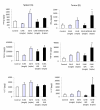Eriobotrya japonica hydrophilic extract modulates cytokines in normal tissues, in the tumor of Meth-A-fibrosarcoma bearing mice, and enhances their survival time
- PMID: 21294856
- PMCID: PMC3045389
- DOI: 10.1186/1472-6882-11-9
Eriobotrya japonica hydrophilic extract modulates cytokines in normal tissues, in the tumor of Meth-A-fibrosarcoma bearing mice, and enhances their survival time
Abstract
Background: Cytokines play a key role in the immune response to developing tumors, and therefore modulating their levels and actions provides innovative strategies for enhancing the activity of antigen presenting cells and polarizing towards T helper 1 type response within tumor microenvironment. One of these approaches could be the employment of plant extracts that have cytokine immunomodulation capabilities. Previously, we have shown that the Eriobotrya japonica hydrophilic extract (EJHE) induces proinflammatory cytokines in vitro and in vivo.
Methods: The present study explored the in vivo immunomodulatory effect on interferon-gamma (IFN-γ), interleukin-17 (IL-17), and transforming growth factor-beta 1 (TGF-β1) evoked by two water-extracts prepared from EJ leaves in the tissues of normal and Meth-A-fibrosarcoma bearing mice.
Results: Intraperitoneal (i.p.) administration of 10 μg of EJHE and EJHE-water residue (WR), prepared from butanol extraction, increased significantly IFN-γ production in the spleen (p < 0.01) and lung (p < 0.03) tissues at 6-48 hours and suppressed significantly TGF-β1 production levels (p < 0.001) in the spleen for as long as 48 hours. The latter responses, however, were not seen in Meth-A fibrosarcoma-bearing mice. On the contrary, triple i.p. injections, 24 hours apart; of 10 μg EJHE increased significantly IFN-γ production in the spleen (p < 0.02) while only EJHE-WR increased significantly IFN-γ, TGF-β1 and IL-17 (p < 0.03 - 0.005) production within the tumor microenvironment of Meth-A fibrosarcoma. In addition, the present work revealed a significant prolongation of survival time (median survival time 72 days vs. 27 days of control, p < 0.007) of mice inoculated i.p. with Meth-A cells followed by three times/week for eight weeks of i.p. administration of EJHE-WR. The latter prolonged survival effect was not seen with EJHE.
Conclusions: The therapeutic value of EJHE-WR as an anticancer agent merits further investigation of understanding the effect of immunomodulators' constituents on the cellular components of the tissue microenvironment. This can lead to the development of improved strategies for cancer treatment and thus opening up a new frontier for future studies.
Figures




Similar articles
-
The differential effect of Eriobotrya japonica hydrophilic leaf extract on cytokines production and modulation.Cytokine. 2007 Dec;40(3):235-40. doi: 10.1016/j.cyto.2007.10.003. Epub 2007 Nov 26. Cytokine. 2007. PMID: 18036829
-
Eriobotrya japonica Water Extract Characterization: An Inducer of Interferon-Gamma Production Mainly by the JAK-STAT Pathway.Molecules. 2016 Jun 2;21(6):722. doi: 10.3390/molecules21060722. Molecules. 2016. PMID: 27271577 Free PMC article.
-
Effect of aged garlic extract on immune responses to experimental fibrosarcoma tumor in BALB/c mice.Indian J Cancer. 2014 Oct-Dec;51(4):609-13. doi: 10.4103/0019-509X.175359. Indian J Cancer. 2014. PMID: 26842212
-
Th1-cytokine induction and anti-tumor effect of 55 kDa protein isolated from Aeginetia indica L., a parasitic plant.Cancer Immunol Immunother. 2001 Jul;50(5):251-9. doi: 10.1007/pl00006688. Cancer Immunol Immunother. 2001. PMID: 11499808 Free PMC article.
-
Transforming growth factor-beta (TGF-beta)-mediated immunosuppression in the tumor-bearing state: enhanced production of TGF-beta and a progressive increase in TGF-beta susceptibility of anti-tumor CD4+ T cell function.Jpn J Cancer Res. 1993 Mar;84(3):315-25. doi: 10.1111/j.1349-7006.1993.tb02873.x. Jpn J Cancer Res. 1993. PMID: 8098027 Free PMC article.
Cited by
-
Biological Activities of Extracts from Loquat (Eriobotrya japonica Lindl.): A Review.Int J Mol Sci. 2016 Dec 6;17(12):1983. doi: 10.3390/ijms17121983. Int J Mol Sci. 2016. PMID: 27929430 Free PMC article. Review.
-
A Functional Food Mixture "Protector" Reinforces the Protective Immune Parameters against Viral Flu Infection in Mice.Nutrients. 2018 Jun 8;10(6):743. doi: 10.3390/nu10060743. Nutrients. 2018. PMID: 29890620 Free PMC article.
-
Efficacy and local irritation evaluation of Eriobotrya japonica leaf ethanol extract.Lab Anim Res. 2019 Jun 24;35:4. doi: 10.1186/s42826-019-0003-3. eCollection 2019. Lab Anim Res. 2019. PMID: 31463223 Free PMC article.
-
Dichloroacetate modulates cytokines toward T helper 1 function via induction of the interleukin-12-interferon-γ pathway.Onco Targets Ther. 2014 Feb 7;7:193-201. doi: 10.2147/OTT.S56688. eCollection 2014. Onco Targets Ther. 2014. PMID: 24532971 Free PMC article.
-
IFN-γ, IL-17 and TGF-β involvement in shaping the tumor microenvironment: The significance of modulating such cytokines in treating malignant solid tumors.Cancer Cell Int. 2011 Sep 23;11:33. doi: 10.1186/1475-2867-11-33. Cancer Cell Int. 2011. PMID: 21943203 Free PMC article.
References
-
- Ito H, Kobayashi E, Takamatsu Y, Li SH, Hatano T, Sakagami H, Kusama K, Satoh K, Sugita D, Shimura S, Itoh Y, Yoshida. Polyphenols from Eriobotrya japonica and their cytotoxicity against human tumor cell lines. Chem Pharm Bull. 2000;48:687–693. - PubMed
Publication types
MeSH terms
Substances
LinkOut - more resources
Full Text Sources

